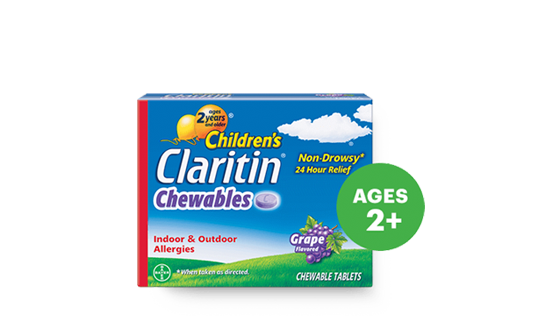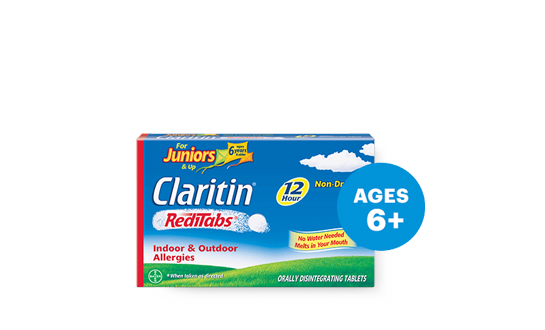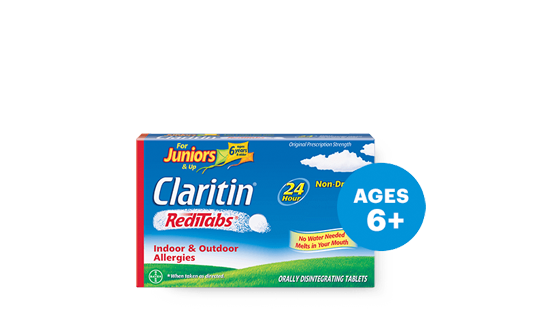Overview
Because they come and go with the seasons, outdoor allergies are often called seasonal allergies. They’re caused by an overreaction of your child’s immune system to certain proteins found outside from sources like mold spores and tree, grass or weed pollens. Depending on where you live and the current weather conditions, seasonal allergies can start as early as February and last until that first frost.1
While seasonal allergens can be difficult to avoid because it seems like they’re everywhere, there are things you can do to help minimize your kid’s exposure and manage their symptoms so they can have more fun.
Select an allergy to learn more:
POLLEN ALLERGIES
MOLD ALLERGIES
Pollen Allergies
Pollen from weeds, trees and grass is a common trigger for seasonal allergies. Pollen spores are small, light and dry, so the wind can carry them long distances. Pollen counts vary, depending on several factors, including the weather, time of day and where you live.
GET YOUR LOCAL POLLEN FORECAST
Tips for Kids with Pollen Allergies
- PLAN PLAY TIME
Try to plan your kid’s outdoor activities when pollen counts are low. And try to keep your child inside on dry, hot and windy days when pollen counts are high as wind can blow pollen further.2
- KEEP POLLEN OUTSIDE
Pollen spores can hitch a ride on your little one’s shoes, clothing and hair and get tracked inside. After spending time outdoors, have your kid take off their shoes, change their clothes and take a quick bath to remove pollen.
- CLEAR THE AIR
When driving, keep windows up and set the air conditioner on "recirculate". At home, keep windows closed, use air conditioning and be sure to change your filters often.
- TAKE COUNT
Pollen levels change often. And when they do, so can your child’s symptoms. Check the pollen count in your area with our pollen forecast tool. - GROW SMART
Plant an allergy-friendly yard for your kids to play in. Some common types of grass produce more pollen spores, including Timothy, Johnson, Bermuda, blue, orchard and sweet vernal grasses. Instead, try planting the female version of buffalo grass as it produces little to no pollen. If you’re planting trees, stick with species, such as Catalpa, Crepe myrtle, dogwood, fir or redwood trees. Avoid planting sunflowers, daisies and chrysanthemums in your yard as they’re all related to ragweed. If you’re not sure what to plant, ask your local garden center before you buy.3
- BE PREPARED
Be sure to keep allergy medicine for kids on hand for when seasonal allergy symptoms strike. Children’s Claritin ® Chewables are for children ages 2 years and older and are easy-to-take tablets and Claritin ® RediTabs ® for Juniors are for children ages 6 years and older and dissolve in your kid’s mouth without water for convenient children’s allergy relief on the go.
Mold Allergies
Overview
Microscopic mold spores float in the air like pollen, causing seasonal allergy symptoms. Outdoors, molds thrive in shady, damp areas, including soil, plants, rotting wood, compost piles or dead leaves.
Since mold thrives in damp spaces, your child’s mold allergy symptoms may be more common during the summer months when it’s hot and humid. Although, they may be prevalent year-round in warmer climates. While pollen spores die with the first frost, mold spores simply go dormant during the winter. And when spring comes, the spores grow back.4
Tips for Kids with Mold Allergies
- LEAVE IT OUTSIDE
Shoes, clothing and hair can all be magnets for mold spores. To help prevent tracking mold in, have everyone remove their shoes before entering your home and make sure your kid changes his or her clothes right away after spending time outside. It’s also a good idea to have your child bathe after playing outdoors. If you’re pinched for time, at least have them wash their hands and face well after coming in.5
- MAKE A MOLD MOVE
To help reduce the number of mold spores from the yard that can enter your home, keep leaves, grass and yard clippings away from the house. You can also try to cut back any trees and/or brush that are close to the house.5
- SKIP THE LINE
Bedding or clothing hung out to dry on a clothes line may pick up mold spores. Use a clothes dryer instead.5
REFERENCES
- Six Things You Should Know About Ragweed. Claritin Blue Sky Living. Accessed September 15, 2017.
- A Quick Guide to Party Planning During Allergy Season. Claritin Blue Sky Living. Accessed September 15, 2017
- Spring Gardening with Allergies. Claritin Blue Sky Living. Accessed September 15, 2017.
- Mold Allergy. Asthma and Allergy Foundation of America. Accessed September 14, 2017.
- Fall Leaves Are Great for the Garden but Can Be Not So Good for Allergies. Claritin Blue Sky Living. Accessed September 14, 2017.










